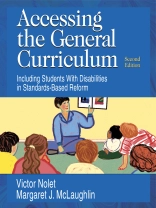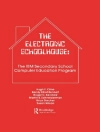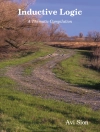Give your students access to the general curriculum and find better ways to assess their progress!
How is your special-education curriculum impacted by the requirements of IDEA and NCLB? How can you improve student learning and retention to positively influence assessment results? What methods are available for determining your students′ present level of performance? In this second edition of the best-selling Accessing the General Curriculum, Nolet and Mc Laughlin provide updated frameworks and strategies-with invaluable examples and flowcharts for fitting special education into the frameworks created by national standards and assessments.
This invaluable resource provides K-12 educators with the support necessary to produce expected results from every learner. The authors begin with far-reaching legal implications and connect them with individual students to show teachers how to:
- Use curriculum as a map for guiding students toward achievement
- Understand learning research as a bridge to the learning-teaching connection
- Relate each student′s disability to his or her academic performance
- Design alternate assessment tools and curriculum
- Link goals, objectives, and benchmarks to state assessment criteria
Affording special education students accommodations and modifications to their individual curriculum will improve their performance, enhance your ability to help them advance, and, ultimately, improve the evaluation of their progress throughout their academic career.
قائمة المحتويات
Introduction
Acknowledgments
1. Access to the General Curriculum: Why it is More Important Than Ever Before
The IDEA and Access to the General Curriculum
The No Child Left Behind Act
The Link Between ‘Standards’ and ‘Curriculum’
A New Way to Think About Special Education
2. The Nature of Curriculum
Multiple Types of Curriculum
The Core Elements of Curriculum
What is the Purpose of Curriculum?
Curriculum Involves a Domain
Curriculum and Time
Finding the General Curriculum
Chapter Summary
3. The Learning-Teaching Connection
Learning Research and Implications for Teaching
Help Students Develop Meaningful Patterns of Information
Creating Experts
Teach to Improve Your Student′s Memory
Help Students Attend to What You Want Them to Learn
Make Effective Use of Practice
Make Effective Use of Scaffolding
Help Students Manage Their Own Learning
Teach for Transfer and Generalization
The Learning-Teaching Connection
4. Assessment That Supports Access to the General Curriculum
Assessment and Decision-Making
What Will Typical Students Be Expected to Do During the Timeframe Addressed by the IEP
What is the Student′s Present Level of Performance in the General Curriculum?
In What Ways is the Student′s Disability Impacting Performance?
Is the Student Making Progress in the General Education Curriculum?
5. Access to Curriculum and the Individual Education Program
Curriculum Access on a Continuum
Universal Design for Learning
Multiple Means of Representation
Accommodations
Modifications
Accommodations and Modifications and Assessment
Special Education and Related Services
6. A Decision-Making Process for Creating IEPs That Lead to Curriculum Access
Step 1: Instructional Assessment
Step 2: Choosing the Standards and Identifying Supports
Step 3: Creating IEP Goals, Objectives, and Benchmarks
The Relationship Between Objectives and Benchmarks
References
Index
عن المؤلف
Margaret Mc Laughlin has been involved in special education all of her professional career, beginning as a teacher of students with serious emotional and behavior disorders. Currently she is the associate director of the Institute for the Study of Exceptional Children, a research institute within the College of Education at the University of Maryland. She directs several national projects investigating educational reform and students with disabilities, including the national Educational Policy Reform Research Institute (EPRRI), a consortium involving the University Maryland; The National Center on Educational Outcomes (NCEO); and the Urban Special Education Collaborative. She also directs a national research project investigating special education in charter schools and leads a policy leadership doctoral and postdoctoral program in conducting large-scale research in special education. Mc Laughlin has worked in Bosnia, Nicaragua, and Guatemala in developing programs for students with developmental disabilities. She has consulted with numerous state departments of education and local education agencies on issues related to students with disabilities and the impact of standards-driven reform policies. Mc Laughlin co-chaired the National Academy of Sciences Committee on Goals 2000 and Students with Disabilities, which resulted in the report Educating One and All. She was a member of the NAS committee on the disproportionate representation of minority students in special education.Mc Laughlin teaches graduate courses in disability policy and has written extensively in the area of school reform and students with disabilities. She earned her Ph D at the University of Virginia and has held positions at the U.S. Office of Education and the University of Washington.












